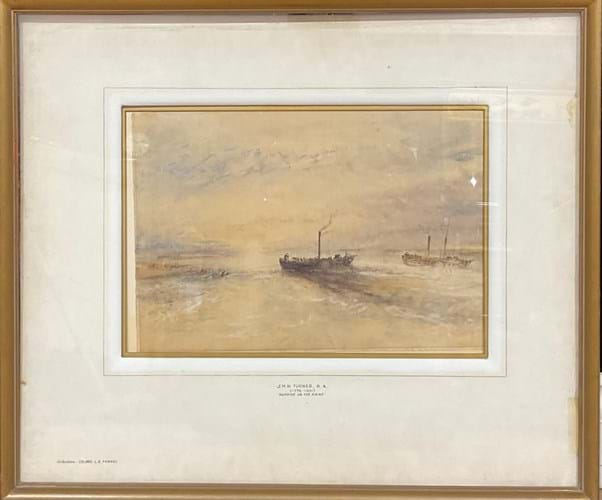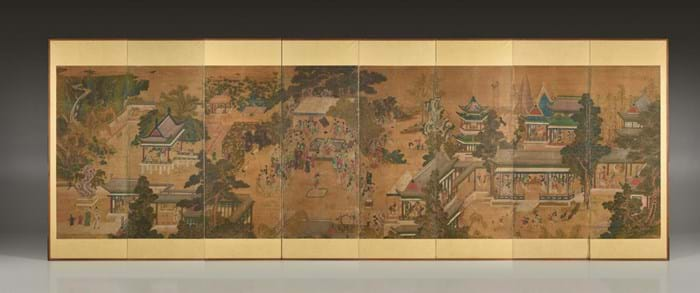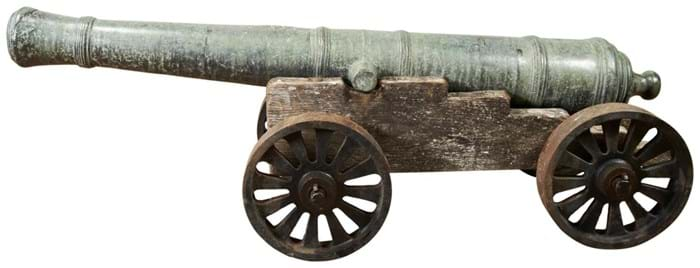
Catalogued as ‘circle of JMW Turner’, this watercolour titled Sunrise on the Rhine sold for £19,000 at Bamfords.
1. ‘Circle of’ Turner watercolour – £19,000
The most eagerly contested lot in the four-day sale at Bamfords in Derby on October 31-November 3 was this watercolour of steamboats on the Rhine in the manner of JMW Turner. Estimated at £200-300, it took £19,000.
The atmospheric sketch measuring 9.75 x 14.25in (25 x 36cm) came in a mount with a full attribution alongside the title Sunrise on the Rhine.
The inclusion to the bottom left of the name Colonel LG Fawkes doubtless contributed to the bidding. Lionel Grimston Fawkes was the grandson of the reforming Yorkshire MP Walter Ramsden Hawkesworth Fawkes (1769-1825), Turner’s friend and one of his earliest patrons. Turner was welcomed at Fawkes's Wharfedale residence Farnley Hall whenever he chose to go and used to spend months at a time there. Fawkes owned about 200 of the artist's works.
Turner is considered one of the fathers of Rhine romanticism. He first visited the region in 1817 with the work purporting the date from the 1820s.
2. Qianlong period dragon box – £110,000
A Chinese ‘dragon’ box fashioned in the prized Asian wood zitan sold for £110,000 at Sworders on November 3. It was the top price of the designated Asian Art sale in Stansted Mountfitchet.
The 49cm wide casket, that would have been used to store books or precious objects is made almost exclusively of zitan, a purplish-black, fine-grained timber (so dense that it sinks in water), that was the preferred wood of the imperial workshops. Suitable for fine and intricate carving, the box in this case is adorned with the powerful dynastic images of the five-clawed dragon amid clouds (symbol of the emperor) and phoenixes (the empress).
By the early Qing period, zitan had become a very expensive commodity (many of the native species had been exhausted during the Ming dynasty) and its use was carefully controlled. When this box was made by master Chinese carpenters in the 18th or early 19th century, it would have been extraordinarily expensive. It remains so today.
The box, that came for sale from a seller in Norfolk with a modest estimate of £1000-2000 attracted bids from multiple suitors before selling at a price that was akin to that of similar pieces offered at showpiece sales in Hong Kong.
3. 18th century Korean screen – £175,000
This 18th century Korean eight-panel screen depicts a subject borrowed from Ming prototypes – a banquet honouring the famed Tang dynasty general Guo Ziyi.
By the 17th century, Guo Ziyi, who lived a long life and raised eight successful sons, had become a paragon of Confucian virtue, and a metaphor for conveying wishes for longevity, wealth, and rank. Screens like this would have been used at celebrations and given as congratulatory gifts to distinguished members of the Joseon court.
More than 40 similar screens are known in museums collections but only a few are signed and sealed. This example, that came for sale as part of the Asian art sale at Dreweatts in Newbury on November 8-9, has two seals for the artist Kim Deuk-sin (1754-1822), the son of a royal court painter, Kim Eungri.
The estimate was £8000-10,000 but bidding reached £175,000. It was sold to a US bidder who intends it to go to an institution.
The screen was originally from a private West Coast collection in the US, having been purchased in Tokyo in 1946. At the time the family ran the US occupying forces entertainment programme.
4. Charles Rennie Mackintosh drawing – £30,000
A group of Charles Rennie Mackintosh (1868-1928) watercolours and drawings were sold on behalf of the Glasgow Art Club at Lyon & Turnbull. The cache of seven market-fresh works on paper, including four flower studies, had belonged to William Meldrum, Mackintosh’s friend and fellow student at the Glasgow School of Art in the 1880s.
They formed part of the 1933 Mackintosh memorial exhibition in the MacLellan Galleries on Glasgow’s Sauchiehall Street and were gifted to the Glasgow Art Club in 1984.
Mackintosh began creating pencil on paper flower sketches as far back as his student days in the 1880s. The 26 x 20cm pencil drawing Anemonie is one such early example. He notes in the cartouche that the plant was found at Lamlash on Arran in 1893, pressed, and then sketched three years later in 1896. It was modestly estimated at £4000-6000 but sold for £30,000.
It was during a 10-month period in 1914-15, that Mackintosh – who had left his architectural practice in Glasgow under a cloud – created a celebrated series of botanical watercolour studies at Walberswick in Suffolk. One contemporary suggested Mackintosh produced them for a book commissioned by a German publisher (a project shelved after the outbreak of war) but it was also an opportunity to re-sharpen his artistic vision.
While another watercolour, Lavender, Walberswick, also sold at £30,000, the remaining sketches ranged from a pencil on tracing paper design for a fabric pattern sold at £2000 to £6500 for a series of pencil and watercolour plant studies on a single sheet dated c.1900.
The group was offered as part of L&T’s Edinburgh sale on October 11 titled Design Since 1860.
5. Chinese naval cannon – £165,000
This rare 17th century Chinese bronze naval cannon guided at £30,000-50,000 made £165,000 at Dore & Rees in Frome on November 6.
Acquired by a West Country military family in the early 20th century, it came by descent.
The barrel bears an inscription translating as: The third month of Qianlong 54th year, In the year of 1789. Fu Jian Navy commander ordered the counting of the weapon from ‘Zuo Ying’. However, it is thought that the weapon was perhaps a century old at this point.
It was further inscribed with the mark for Guo Xing Fu, which refers to ‘Zheng Cheng Gong’ who was a southern Ming general who resisted the Qing conquest of China in the 17th century and fought them on China’s south-eastern coast. Dore & Rees says this cannon was probably used by the navy of Zheng to fight the Qing navy during the time. In 1661 Zheng Chenggong defeated a Dutch outpost in Taiwan and established a dynasty, the house of ‘Guo Xing ye’.
The approximately 5ft 5in (1.66m) long cannon, model no 20, is supported on a wooden carriage and weighs 430kg. There is a similar example in a museum in Xiamen.










